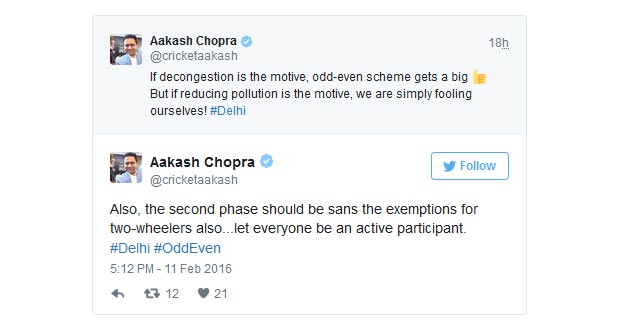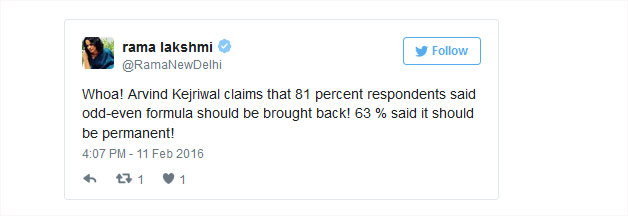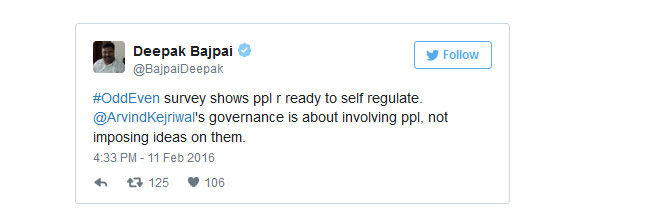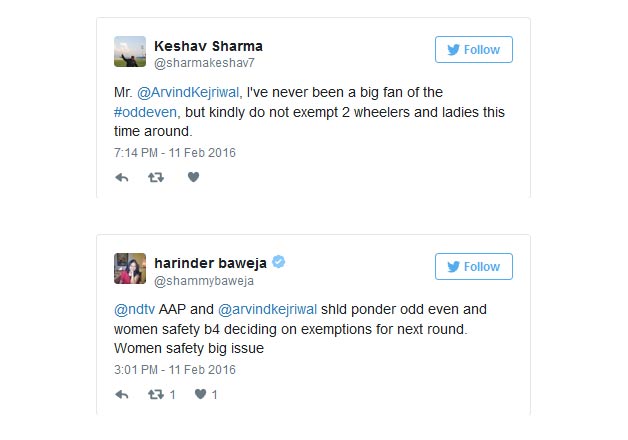
Delhi's January attempt to reduce road congestion (and the air pollution it causes) by using license plate numbers to restrict driving was a success: both congestion and air pollution were down in the 15-day trial period relative to the rest of the National Capital Region (NCR), according to a new study that used both government and IndiaSpend pollution monitor data.
But with a new odd-even test set for April, does that mean restricting license plates is the answer to Delhi's infamous congestion?
The answer, in the short term, is no. And it is not clear that expanding the program–implementing permanent even/odd driving restrictions–will solve Delhi's congestion and air pollution problems in the long term either.


The even/odd license plate scheme, authorised under the Motor Vehicle Act, is an example of air pollution regulation that relies on blunt rules and prohibitions. In contrast, the most effective pollution regulations in the developed world are based on the principle that polluters should pay for the cost of their pollution.

The “polluter pays” principle recognises that pollution causes damages, and these damages vary depending on when and where pollution occurs. As a result, penalties and restrictions should vary in the same way.
This contrasts with the broad even/odd restrictions, under which drivers are forbidden to drive on certain days and are punished with a simple fine if they violate this rule. It is an all-or-nothing regulation that fails to allow for individual flexibility (aside from a vast swathe of exceptions), whose penalties are not tied to the severity of the pollution caused.

London, Singapore have relied on congestion taxes for more than 10 years
Congestion taxes offer an alternative to the all-or-nothing, punitive approach of license plate restrictions.
Instead, drivers are charged whenever they enter a defined area of the city during peak traffic periods. Such taxes are a form of “polluter pays” regulation that have been shown to reduce urban air pollution in the long term (most notably in London and Singapore, both of which have relied on congestion taxes for more than ten years).
London's congestion tax was introduced in 2003 as a tax on all vehicles entering the downtown area. Motorists pay £11.50 each time they enter a pre-defined area in downtown London between 7 am and 6 pm on non-holiday weekdays.
Enforcement is carried out by comparing the number plates of entering vehicles to a database of vehicles of registered owners. London estimates that their congestion charge has reduced traffic by 20% and increased travel speed in the city centre by 17%. Air pollution has fallen by 16%.
Singapore has also successfully implemented a congestion tax; drivers are charged based on distance travelled in the urban centre. It has reduced traffic by 24% since 1998. Stockholm has implemented a tax that varies based on the time of day travel takes place. And especially relevant for Delhi: Tehran has implemented a successful congestion tax in the urban centre, demonstrating that these schemes can be employed outside the developed world.
The idea behind congestion taxes is simple. Driving a car on Delhi roads imposes damages (costs) on everyone else on or around that road. These costs vary with the amount of other traffic on the road, which varies by day and time of day.
Right now, drivers pay none of these costs directly–use of the roads is essentially free. As a result, the roads in Delhi are overused.
Congestion taxes force drivers to pay the costs that they impose on others when they drive. As experience from Stockholm to Tehran has shown, use of the roads would no longer be free and demand for road space would fall.
Congestion taxes can be varied to account for the difference in external costs at different times and on different days. And they allow drivers the freedom to choose when it is most worthwhile for them to drive, rather than forcing them to only drive at certain times.
Congestion pricing may result in fewer attempts to circumvent laws
In contrast, license plate restrictions act as a blanket restriction forbidding certain people from driving at certain times. Congestion taxes do not forbid driving, but still reduce congestion. If it is very important that a motorist drive at a certain day or time, a congestion tax does not prevent them from doing so.
Due to this increased flexibility, congestion pricing may result in fewer attempts to circumvent the regulations by purchasing additional cars or license plates. For example, London has seen persistent violations (which include tampering with the number plate used in enforcement) by fewer than 2% of the vehicles entering the city.
On the other hand, evidence from both Beijing and Sao Paulo, which have experimented with license plate restrictions, suggests that restrictions have not led to a reduction in cars purchased in the city. Further, evidence from Mexico City's license plate restriction program indicates that citizens purchase multiple cars for the purpose of avoiding the regulations. In Mexico City, these second cars tended to be older and less efficient than new ones, so the program ultimately resulted in little or no improvement in congestion–and actually made air pollution worse.
While Delhi's experiment with even/odd restrictions succeeded in reducing emissions by 10-13% and increased average speeds by 5.4%, these impacts could disappear over the long term if citizens adapt by purchasing additional cars or plates to avoid the restrictions.
Those who choose to drive should pay the costs
Air pollution and congestion in Delhi are not unsolvable problems. But a viable solution must be sustainable over the long term. License plate restrictions have historically encouraged drivers to game the system through the purchase of additional cars or license plates, and do not change behaviour. Forcing polluters to pay for their pollution through congestion taxes, on the other hand, is policy mechanism that has successfully reduced pollution in many places around the world.
Driving costs the residents of Delhi. Those who choose to drive should pay those costs.
Vehicular pollution is a part of a larger problem, as IndiaSpend has reported. Unless complementary steps are initiated to control pollution from other sources, measures like the even/odd formula will prove inadequate to deal with Delhi's pollution problem.

Note: Chart by Eric Dodge in this story.
Congestion taxes have a final advantage over license plate restrictions: they raise revenue that can be used to build a more efficient public transportation network. Such a network further reduces congestion and eases the transition away from personal car travel. The reinvestment of revenue from congestion pricing in better bus- and subway-systems has been an essential part of congestion reduction programs from London to Bogota.
Delhi's pilot attempt to reduce air pollution and congestion with license plate restrictions was an ambitious first step. But the momentum from its success should be capitalised and built upon with a similar pilot of congestion pricing. While it is clear that congestion pricing has successfully reduced congestion and air pollution in cities around the world, Delhi is unique. There will be specific challenges to implementing congestion pricing here.
In particular, as with license plate restrictions, enforcement of congestion pricing will be a challenge. Tehran overcame this challenge first with visual inspection of vehicles for proof of payment at key points around the city and now with inspection by camera. Singapore relies on radio transmitters in vehicles. Delhi may develop its own solution.
Running a pilot of congestion pricing will provide information to overcome this, and other challenges to implementing a congestion price. Expanding the scope of pollution-curbing experiments will also give policy makers the data necessary to decide what is best for Delhi based on local evidence.
(Behrer is a PhD student at Harvard University focusing on environmental economics. He has worked with the Evidence for Policy Design group at Harvard University on measuring traffic congestion in Delhi.)

















